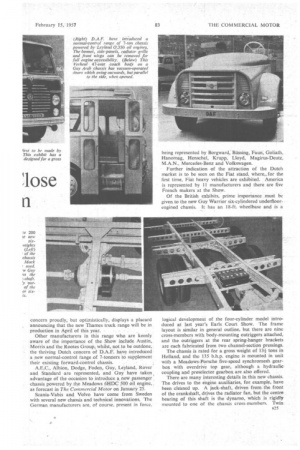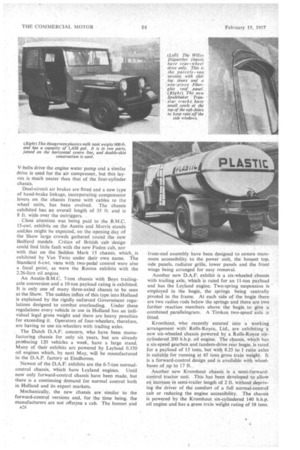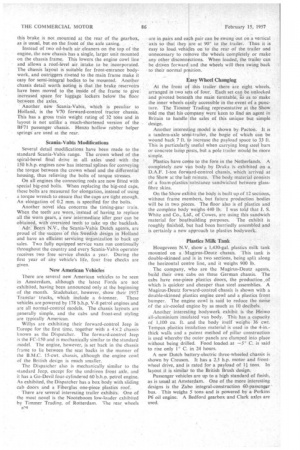World Mak( lose on Avast
Page 58

Page 59

Page 60

Page 61

Page 62

If you've noticed an error in this article please click here to report it so we can fix it.
Seven Countries are Represented at the 1957 Amsterdam Commercial Motor Show and Competition is Keen : Guy Show New Passenger Chassis and New Bedfords are Announced
By John F. Moon, A.M.I.R.T.E.
THE importance of this year's Amsterdam Commercial Motor Show, which closes tomorrow, has been increased immeasurably by the cancellation of the Brussels Motor Show. The 1957 R.A.1. Show, therefore, assumes the character of a sales battlefield with virtually no holds barred, as manufacturers from all over the world realize the importance of the Dutch market.
Fierce competition is to be seen in the large numbers of vehicles which had obviously been finished within hours of the opening of the Show on February 7. It is further emphasized by the rivalry between competitive manufacturers in the same ranges of vehicle.
Thus, General Motors Continental saw fit to introduce the new Bedford range of commercial vehicles a week before it was officially scheduled to be announced in Great Britain, whilst alongside them the Dutch Ford concern proudly, but optimistically, displays a placard announcing that the new Thames truck range will be in production in April of this year. • • Other manufacturers in this range who are keenly aware of the importance of the Show include Austin, Morris and the Rootes Group, whilst, not to be outdone, the thriving Dutch concern of D.A.F. have -introduced a new normal-control range of 7-tonners to supplement their existing forward-control chassis. • A.E,C., Albion, Dodge, Foden, Guy, Leyland, Rover and Standard •are represented,. and Guy have taken, advantage of the occasion to introduae a, new passenger , chassis powered by the Meadows 6I-IDC 500 oil engine,. as forecast in The Commercial Motor on January 25.
Scania-Vabis and Volvo havecome from Sweden with several new chassis and technical innovations. The German manufacturers are, of course, present in force. being represented by Borgward,. Missing, Faun, Goliath, Hanomag, Henschel, Krupp, Lloyd, Magirus-Deutz, M.A.N., Mercedes-Benz and Volkswagen.
Further indication of the attraction of the Dutch market is to be seen on the Fiat stand, where,.for the first time, Fiat heavy vehicles are exhibited. America is represented by 11 manufacturers and there are five French makers at the Show.
Of the British exhibits, prime importance must be given to the new Guy Warrior six-cylindered underfloorengined chassis. It has an 18-ft. wheelbase and is a logical development of the four-cylinder model introduced at last year's Earls Court Show. The frame layout is similar in general outline, but there are nine cross-members with body-mounting outriggers attached, and the outriggers at the rear spring-hanger brackets are each fabricated from two channel-section pressings.
The chassis is rated for a gross weight of 13f tons in Holland, and the 135 b.h.p. engine is mounted in unit with a Meadows-Porsche five-speed synchromesh gearbox with overdrive top gear, although a hydraulic coupling and preselector gearbox are also offered.
There are many interesting details in this new chassis. The drives to the engine auxiliaries, for example, have been cleaned up. A jack-shaft, driven from the front of the crankshaft, drives the radiator fan, but the centre bearing of this shaft is the dynamo, which is rigidly mounted to one of the chassis cross-members. Twin V-belts drive the engine water pump and a similar drive is used for the air compressor, but this lay out is much neater than that of the four-cylinder chassis.
Dual-circuit air brakes are fitted and a new type of hand-brake linkage, incorporating compensator levers on the chassis frame with cables to the wheel units, has been evolved. The chassis exhibited has an overall length of 35 ft. and is 8 ft. wide over the outriggers.
• Close attention was being paid to the B.M.C. 15-cwt. exhibits on the Austin and Morris stands and,Oas might be expected, on the opening day of the Show large crowds gathered round the new Bedford models. Critics of British cab design could find little fault with the new Foden cab, nor with that on the Seddon Mark 15 chassis, which is exhibited by Van Twist under their own name. The Standard 6-cwt. vans with two-pedal control were also a focal point, as were the Rootes exhibits with the 2.26-litre oil engine.
An Austin-B.M.C. 7-ton chassis with Boys trailingaxle conversion and a 10-ton payload rating is exhibited. It is only one of many three-axled chassis to be seen at the Show. The sudden influx of this type into Holland is explained by the rigidly enforced Government regu lations designed to combat overloading. Under these regulations every vehicle in use in Holland has an indi vidual legal gross weight and there are heavy penalties for exceeding it. Operators of four-wheelers, therefore, are having to use six-wheelers with trailing axles.
The Dutch D.A.F. concern, who have been manufacturing chassis for only six years, but are already producing 120 vehicles a week, have a large stand. Many of their exhibits are powered by Leyland 0.350 oil engines which, by next May, will be manufactured in the D.A.F. factory at Eindhoven.
Newest of the D.A.F. exhibits are the 6-7-ton normalcontrol chassis, which have Leyland engines. Until now only forward-control chassis have been made, but there is a continuing demand for normal control both in Holland and its export markets.
Mechanically, the new chassis are' similar to the forward-control versions and, for the time being, the manufacturers are not offering a cab. The bonnet and a26 front-end assembly have been designed to ensure maximum accessibility to the power unit, the bonnet top, side panels, radiator grille, lower panels and the front wings being arranged for easy removal.
Another new D.A.F. exhibit is a six-wheeled chassis with trailing axle, which is rated for an 11-ton payload and has the Leyland engine. Two-spring suspension is employed in the bogie, the springs being centrally pivoted to the frame. At each side of the bogie there are two radius rods below the springs and there are two further reaction members above the bogie to give a combined parallelogram. A Timken two-speed axle is fitted.
Kromhout, who recently entered into a working arrangement with Rolls-Royce,. Ltd., are exhibiting a new six-wheeled chassis powered by a Rolls-Royce sixCylindered 200 b.h.p. oil engine. The chassis, which has a six-speed gearbox and tandem-drive rear bogie, is rated, for a payload of 15 tons, but with 8.25 to 1 ratio axles is suitable for running at 45 tons gross train weight. It is a forward-control design and is available with wheel.. bases of up to 17 ft.
Another new Kromhout chassis is a semi-forwardcontrol tractor unit. This has been developed to allow an increase in semi-trailer length of 2 ft. without depriving the driver of the comfort of a full normal-control cab or reducing the engine accessibility. The chassis iS powered by the Kromhout six-cylindered 140 b.h.p. oil engine and has a gross train weight rating of 38 tons. On the Volvo stand the 3-ton forward-control petrol-engined chassis is exhibited for the first time in public, together with an even newer 7-ton forwardcontrol oiler which has only just been announced.
The 7-tonner is shown with a cab built by F. J. A. van Rick and is mechanically similar to the standard normal control 7-tonner. The braking system, to`sv-• ever, looks hardly adequate for a vehicle which will run at 12 tons gross, as the serNo is only ,a single Lockheed Hydrovac. The chassis exhibited has a 15 ft 5-in. Wheelbase, but a short wheelbase version is also produced. The unladen chassis Weight is approximately 4 tons and a 115 b.h.p. six-cYliridered oil engine is employed in conjunction with a fivespeed gearbox.
A new L.P.G.engine is shown by Volvo. This is based on a 115 b.h.p. petrol engine, which can be converted to L.P.G. operation without major internal modifications. It is a 4.7-litre six-eylindered over head-valve unit with a 7-to-1 compression ratio and when operating on L.P.G. it develops 120 b.h.p. at 3,000 r.p.m.
Scania-Vabis have a new passenger chassis, the BF73, which is rated for a gross weight of 14+ tons, with a maximum front-axle loading of 6+ tons. ZF-Gemnner hydraulic power steering is fitted.
This chassis is similar to the BF71 13-ton-gross design, but the permissible front-axle loading is a ton greater. It is powered by a 150 b.h.p. oil engine and the Leyland Pneumo-Cyclic semi-automatic transmission is offered as an alternative to the five-speed synchromesh box normally fitted. The suspension is interesting: Mack rubber spring mountings are used at both ends of the rear springs and at the rear ends of the front springs, but conventional shackle pins are employed at the front of the front springs, so as to give positive location and reduce the risk of steering flexibility. Bendix-Westinghouse air-pressure brakes are standard equipment and, as with all Scania-Vabis chassis, a transmission hand brake is employed. Because there are three propeller shafts in the transmission line, however,
this brake is not .mounted at the rear of the gearbox, as is usual, but on the front of the axle casing.
Instead of two oil-bath air cleaners on the top of the engine, the new chassis has a single, larger unit mounted on the chassis frame. This lowers the engine cowl line and allows a roof-level air intake to• be incorporated_ The chassis layout is suitable for front-entrance bodywork, and outriggers riveted to the main frame make it easy for semi-integral bodies to be mounted. Another chassis detail worth noting is that the brake reservoirs have been moved to the inside of the frame to give' increased space for luggage lockers below the floor between the axles.
• Another. new Scania-Vabis, which is peculiar to gonad& is the V70 forward-control tractor chassis. This has a gross train weight rating of 32 tons and in layout is not unlike a much-shortened version of the BF71 passenger 'chassis. Henzo hollow rubber helper springs are used at the rear.
• Scania-Vabis Modifications
Several detail modifications have been made to the standard Scania-Vabis range. The crown wheel of the spiral-bevel final drive in all. axles used with the 150 b.h.p. engines now has internal splines for conveying the torque between the crown wheel and the differential housing, thus relieving the bolts of torque stresses. On all engines the connecting rods are now fitted with special big-end bolts. When replacing the big-end caps, these bolts are measured for elongation, instead of using a torque wrench to ensure that the caps are tight enough. An elongation of 0.2 mm. is specified for the bolts.
Another novel idea concerns the timing-gear train. When the teeth are worn, instead of having to replace all the worn gears, a new intermediate idler gear can be obtained, with oversized teeth to take up the backlash.
Ach2: Beers N.V., the Scania-Vabis Dutch agents, are proud of the success ofthis Swedish design in Holland and have an efficient servicing Organization to back up sales. Two fully equipped service vans run continually throughout the country and every Scania-Vabis operator receives two free service checks a year. During the first year of any Vehicle's life, four free checks are given.
New American Vehicles
There are several new American 'vehicles to be seen in Amsterdam, although the latest Fords are not exhibited, having been announced only at the beginning of the month. Studebaker, however, show (heir 1957
Transtartrucks, which include a 6-tonner. These vehicles are powered by 178 b.h.p. V-8 petrol engines and are all normal-control models. The chassis layouts are generally simple, and the cabs and front-end styling are typically American.
Willys are exhibiting their forward-control Jeep in Europe for the first time, together with a 4 X 2 chassis known as the Dispatcher. The forward-eontrol Jeep is the FC-150 and is mechanically similar to the standard model. The engine, however, is set hack in the chassis frame to lie between the seat backs in the manner of the B.M.C. 15-cwt, chassis, although the engine cowl of the British design is much smaller.
The Dispatcher also is mechanically similar to the standard Jeep, except for the undriven front axle, and it has a Go-Devil four-cylindered 60 'b.h.p. petrol engine. As exhibited, the Dispatcher has a box body with sliding cab doors. and a Fiberglas one-piece plastics roof.
• There are severalinteresting trailer exhibits. One of the most novel is the Nooteboom low-loader exhibited by Timmer Trading. of Rotterdam. The rear wheels
are in pairs and ea h pair can be swung out on a vertical axis so that they IC at 90 to the trailer. Thus it is easy to load vehi les on to the rear of the trailer and unnecessary to re eve the wheels completely or make any other disconn etions. When loaded, the trailer can be driven forward and the wheels will then swing back to their normal p 'tion.
asy Wheel Changing
At the front o this trailer there are eight wheels, arranged in two S ts of four. Each set can be unlocked and pivoted benea h the main" turntable, to as to make the inner wheels e sily accessible in the event of a punclure. The Tim me Trading representative at the Show told me that his c mpany were keen to find an agent in Britain to handle the sales of this unique but simple design.
Another interes 'ng .model is shown by Pacton. It is a tandem-axle se i-trailer, the bogie of which can be wound back 7 ft. t increase the payload space to 33 ft. This is particularl useful when carrying long steel bars or concrete lathp p sts, but a pole trailer would be more simple.
Plastics have co e to the fore in the Netherlands. A completely new v n body by Draka is exhibited on a. D.A.E. 1-ton for ard-control chassis, which arrived at the Show at the la 't minute. The body, material consists of a foam-plastics substance sandwiched between glassfibre skins.
On the Show ex ibit the body is built up of 12 sections, without frame members, but future production bodies will be in two pieces. The floor also is of plastics and the complete body weighs 440 lb. I was told that J. S. White and Co., Ltd., of Cowes, are using this sandwich material for boatbuilding purposes. The exhibit is roughly finished, but had been hurriedly assembled and is certainty a new approach to plastics bodywork.
Plastics Milk Tank
Hoogeveen N.V. show a 1,430-gal. plastics milk tank mounted on a Magirus-Deutz chassis. This tank is double-skinned and is in two sections, being split along the horizontal centre line, and it weighs 900 lb.
The company, who are the Magirus-Deutz agents, build .their own cabs on these German chassis. The cabs have one-piece plastics doors, the production ,of which is quicker and cheaper' than steel assemblies. A Magirus-Deutz forward-control chassis is shown with a double-skinned plastics engine cowl and a plastics front bumper. The engine cowl is said to reduce the noise of the air-cooled engine by as much as 10 decibels.
Another interesting bodywork exhibit is the Heiwo an-aluminium insulated van body. This has a capacity of 1,100 Cu. ft. and the body itself weighs 36 cwt. Tempax.plastics insulation material is used in the 4-in.thick walls and a patent method of pillar construction is used whereby the outer panels are clamped into place without being drilled. Food loaded at —5° C. is said to rise only 1° C. in 24 hours.
A new Dutch battery-electric three-wheeled chassis is shown by Creusen. It has a 2.3 h.p, motor and front. wheel drive, and is rated for a payload of 11 tons. To layout it is similar to the British Brush design.
Passenger vehicles are up to a high 'standardof finish, as is usual at Amsterdam. One of the more interesting designs is the Zabo integral-construction 60-passenggr bus. This weighs 5 tons and is powered by a Perkins P6 oil engine. A Bedford gearbox and Clark axles are used.




















































































































